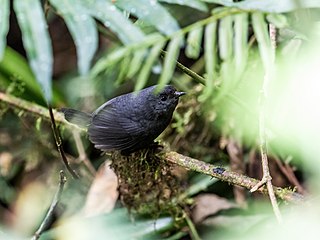 W
WThe American dusky flycatcher, or simply dusky flycatcher, is a small insectivorous passerine of the tyrant flycatcher family.
 W
WThe Ancash tapaculo is a species of bird in the family Rhinocryptidae. It is endemic to Peru.
 W
WThe black-chinned monarch, or Boano monarch, is a species of bird in the family Monarchidae endemic to Indonesia. It is found on Boano island in the southern Mollucas. Its natural habitats are subtropical or tropical moist lowland forest and subtropical or tropical moist shrubland. It is threatened by habitat loss.
 W
WThe horned curassow, or southern helmeted curassow, is a species of bird in the family Cracidae found in humid tropical and subtropical forests. It was first described by James Bond and Rodolphe Meyer de Schauensee in 1939 from a specimen collected in Bolivia, and further birds that were described from Peru in 1971 were thought to be a new subspecies. However, the taxonomical position of the birds found in Peru in 1971 is unclear. The horned curassow as originally described is endemic to Bolivia. It is a large, predominantly black bird with a distinctive casque on its forehead. It is an uncommon bird with a limited range and is suffering from habitat loss, and the International Union for Conservation of Nature has rated its conservation status as being "critically endangered".
 W
WThe Nariño tapaculo is a species of bird in the family Rhinocryptidae. It is found in Colombia, Ecuador, and Panama.
 W
WThe neblina tapaculo or « mist tapaculo », also known as the elfin forest tapaculo, is a species of bird in the family Rhinocryptidae. It is endemic to the northeastern Andes of Peru.
 W
WThe ribbon-tailed astrapia, also known as Shaw Mayer's astrapia, is a species of bird-of-paradise.
 W
WScripps's murrelet is a small seabird found in the California Current system in the Pacific Ocean. This auk breeds on islands off California and Mexico. It is threatened by predators introduced to its breeding colonies and by oil spills.
 W
WThe trilling tapaculo is a species of bird in the family Rhinocryptidae. It is found in Bolivia and Peru. Its natural habitat is subtropical or tropical moist montane forest.
 W
WThe Vilcabamba tapaculo is a small passerine bird endemic to Peru.